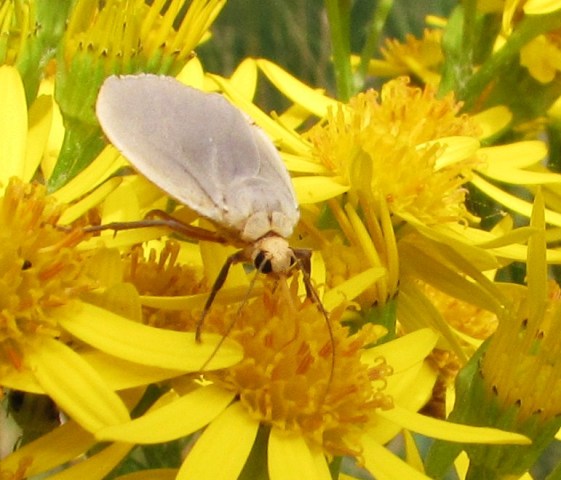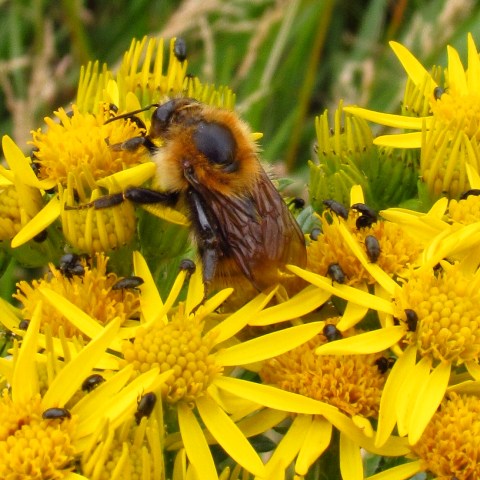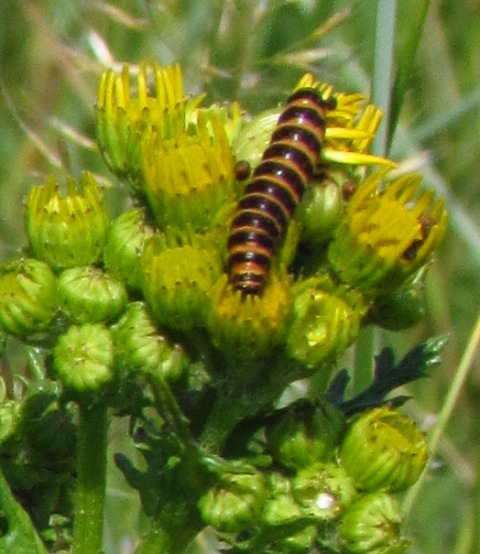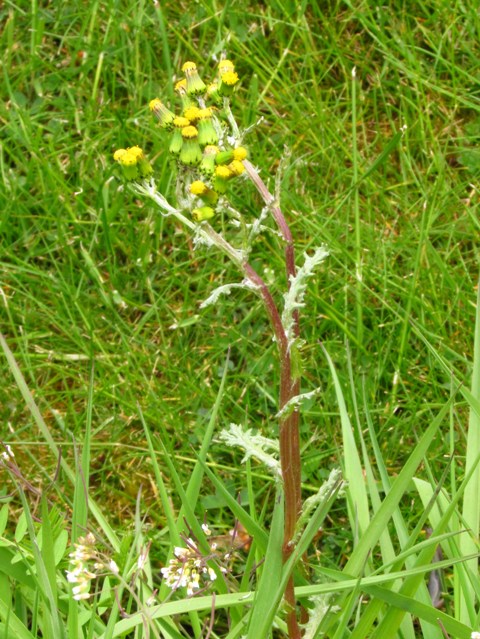
In my previous post all about the classification of the Asteraceae I mentioned Ragwort which used to be in the genus Senecio with 20 species but some have now been split off into the genus Jacobaea.
Today we talk about Senecio and Jacobaea or the Groundsels and Ragworts and their uses. Some of the neophytes can be grown as a garden plant and indeed may have escaped into the wild from your garden……
But the family of Asteraceae is highly evolved to home many insects and supports a rich biodiversity, so is very useful to them!
I use colour coding for easy reading! Blue background is general interesting info (although I hope you find it all interesting!!). Green is about all the uses except for medicinal uses or if there is a warning ( and in this case negative propaganda) in which case I use a pink background. Pictures by Matt Summers, Mike Poulton and Wikipedia.
Contents:
Genus and species of Senecio and Jacobaea
- Senecio cambrensis or Welsh Groundsel
- S. doria or Golden Ragwort (Neophyte)
- S. doronicum or Chamois Ragwort (Neophyte)
- S. eboracensis or York Ragwort
- S. glastifolius or Woad-leaved Ragwort (Neophyte)
- S. inaequidens or Narrow-leaved Ragwort (Neophyte)
- S. minimus or Toothed Fireweed (Neophyte)
- S. ovatus or Wood Ragwort (Neophyte)
- S. sarracenicus or Broad-leaved Ragwort (Neophyte)
- S. smithii or Magellan Ragwort (Neophyte)
- S. squalidus or Oxford Ragwort (Neophyte)
- S. sylvaticus or Heath Groundsel
- S. vernalis or Eastern Groundsel (Neophyte)
- S. viscosus or Sticky Groundsel (Neophyte)
- S. vulgaris or Groundsel
- Jacobaea aquatica or Marsh Ragwort
- J. erucifolia or Hoary Ragwort
- J. maritima or Silver Ragwort (Neophyte)
- J. paludosa or Fen Ragwort
- J. vulgaris or Common Ragwort
Negative points about Ragwort
Positive points about Ragwort
Genus and species of Senecio and Jacobaea
Several species of the former 20 species of Senecio have been moved to Jacobaea;
Below the list of the diferent species now found on the B.I. according to the Plant Atlas 2020 Online. For more information and pictures click on the link below the name:
- Senecio cambrensis or Welsh Groundsel
- S. doria or Golden Ragwort (Neophyte)
- S. doronicum or Chamois Ragwort (Neophyte)
- S. eboracensis or York Ragwort
- S. glastifolius or Woad-leaved Ragwort (Neophyte)
- S. inaequidens: see below
- S. minimus or Toothed Fireweed (Neophyte)
- S. ovatus or Wood Ragwort (Neophyte)
- S. sarracenicus or Broad-leaved Ragwort (Neophyte)
- S. smithii or Magellan Ragwort (Neophyte)
- S. squalidus: see below
- S. sylvaticus: see below
- S. vernalis or Eastern Groundsel (Neophyte)
- S. viscosus: see below
- S. vulgaris: see below
- Jacobaea aquatica: see below
- J. erucifolia: see below
- J. maritima: see below
- J. paludosa or Fen Ragwort
- J. vulgaris: see below
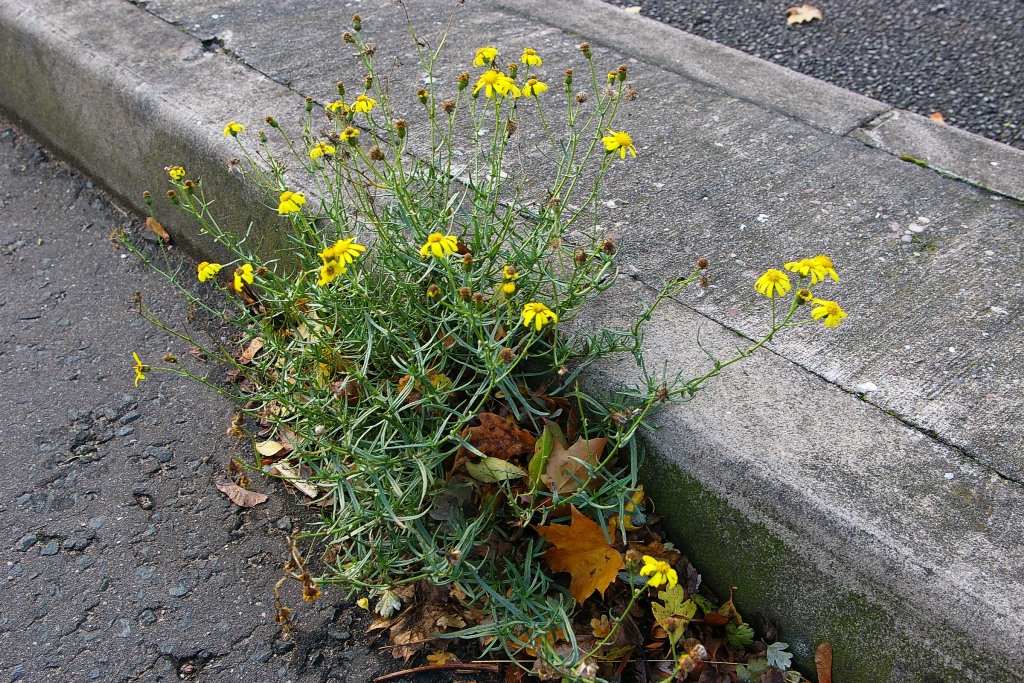
6. S. inaequidens or Narrow-leaved Ragwort (Neophyte)
A clump-forming, winter-green perennial herb with a woody base, now thoroughly naturalized in a range of ruderal habitats including paths, tracks, roadsides, pavements, bridges, railways, spoil and dung heaps, derelict buildings and waste ground. Also occurring on river shingle and sandy beaches and as a casual on arable land.
A native of S. Africa: this species started to increase in 1999 and since then it has spread rapidly throughout Britain and Ireland, mainly along major transport networks, and it is now locally abundant in many urban areas, often forming huge colonies on railway sidings and on derelict land.
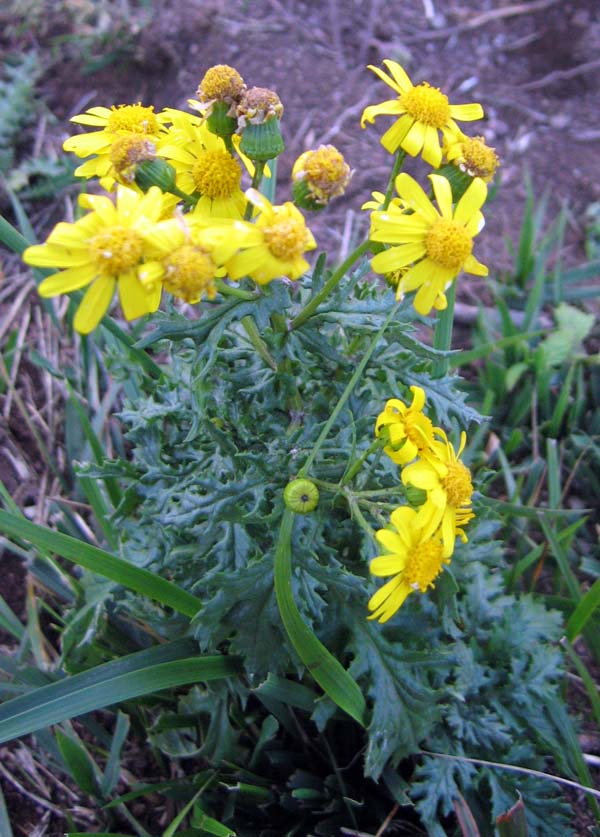
11. S. squalidus or Oxford Ragwort (Neophyte)
A winter-green annual to short-lived perennial herb, found most often as a street weed, where it is found at the base of walls, as well as on other disturbed or waste ground on well-drained soils including railways, cinders, roadsides and gardens.
This plant is native to Sicily where it colonises lava slopes on Mount Etna.
It was first recorded in the wild in 1794 as an escape from Oxford Botanic Garden, and at Bideford, North Devon sometime before 1830. It spread rapidly after reaching the railway in Oxford in c. 1879 and, by the 1960s, was present over much of southern Britain and was starting to colonize other habitats. This increase continued until the 1980s but since then its distribution has declined, especially since 2000, possibly due to street cleansing and redevelopment of derelict urban sites.
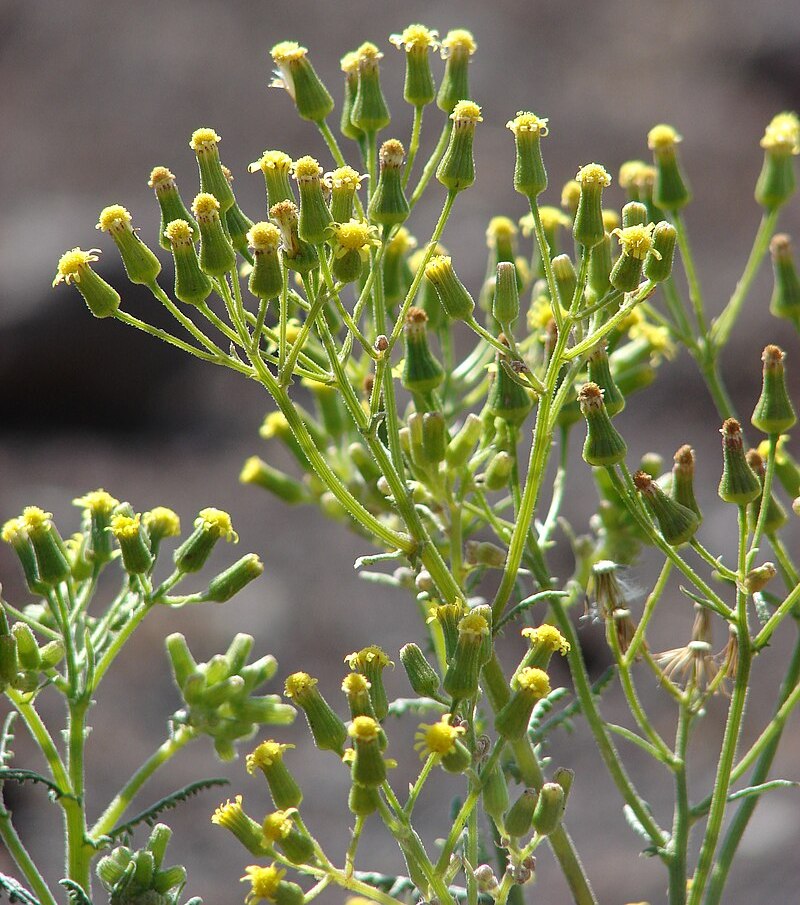
12. S. sylvaticus or Heath Groundsel
A slender annual of open habitats on heathlands, often in disturbed areas, in cleared and burnt woodland, and on bushy commons; less often on railways, mine spoil, screes and sea-cliffs. It usually grows on acid, sandy, non-calcareous, sometimes eroded soils.
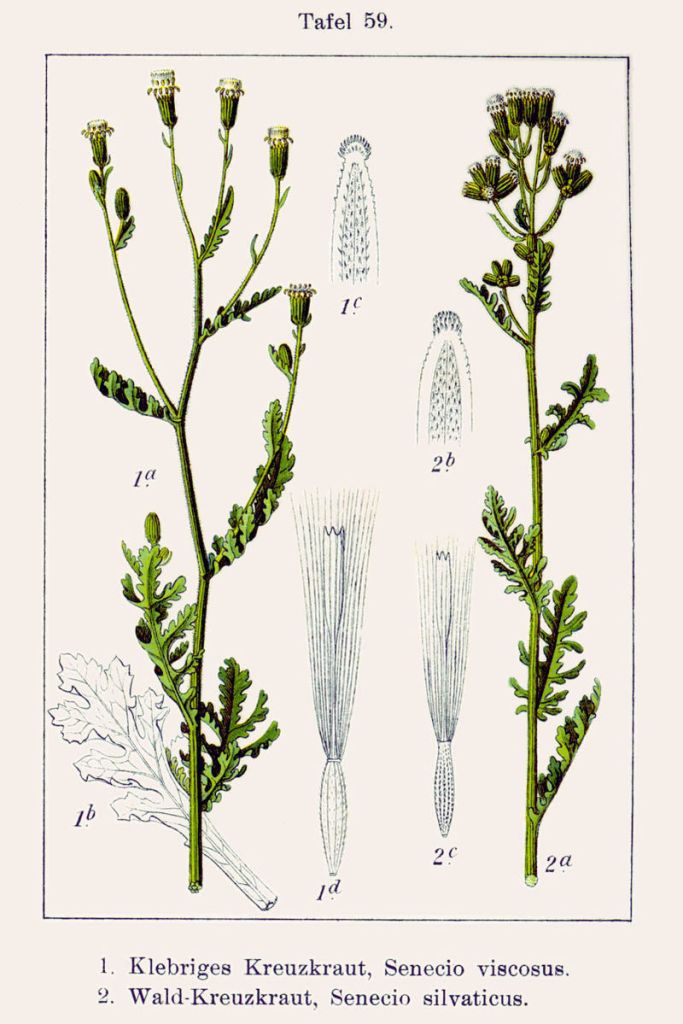
14. S. viscosus or Sticky Groundsel (Neophyte)
An annual herb, found on roadsides, banks, wall-tops, pavements, railway ballast, coastal shingle and dunes, in gravel-pits, and on open rough and waste ground and refuse tips. Usually growing on free-draining, disturbed substrates such as sands, gravels and cinders.
15. S. vulgaris or Groundsel
An annual of open and disturbed ground, occurring in semi-natural habitats on sand dunes and coastal cliffs, and as a weed of waste places, roadsides, pavements, arable fields and other open habitats, often on nutrient-rich ground.
The seed of common groundsel is a good green food for canaries and finches and it is available all year round.
Senecio vulgaris is food for many herbivores, moths, caterpillars, beetles, flies and fungi. Most Senecio, including S. squalidus are susceptible to rust and other fungus and mildews.
All species of the genus Senecio contain pyrrolizidine alkaloids (e.g., senecionine), a substance that when a human has chronic exposure can cause irreversible liver damage.
Common groundsel as a medicinal herb does not seem to have been recommended very often since 1931, when it was recommended as a diaphoretic, an antiscorbutic, a purgative, a diuretic and an anthelmintic, which was a demotion as it was previously suggested for the expelling of gravel of the kidneys and reins by Pedanius Dioscorides in the 1st century, for use as poultices by John Gerard in the late 16th century and as a cure for epilepsy by Nicholas Culpeper in the 17th century!
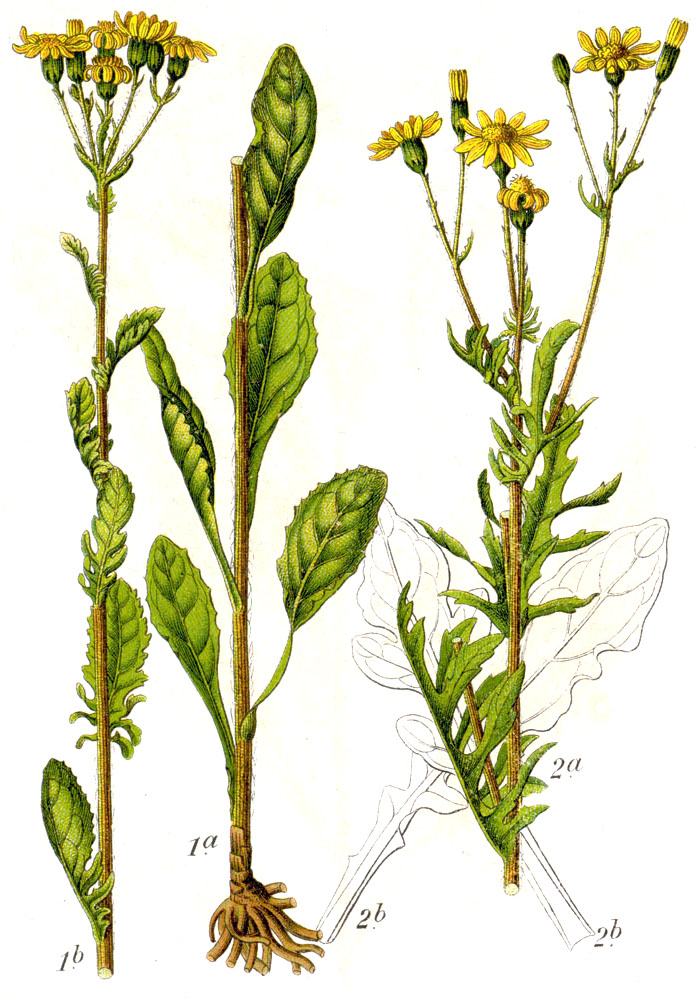
16. Jacobaea aquatica or Marsh Ragwort
A yellow-flowered biennial, sometimes perennial, herb of marshes, wet meadows, fens, swamps, rush-pastures, damp woods and by streams, ponds and ditches. Its leaves are very variable in shape.

17. J. erucifolia or Hoary Ragwort (and here for great pictures!)
A yellow-flowered perennial herb of grassland and disturbed habitats, including hay meadows and pastures, chalk and limestone downland, field-borders, railway banks, roadsides, waste places, shingle banks and fixed sand dunes; it is usually found on neutral or calcareous soils, especially clays that are wet in winter but baked dry in summer. Four varieties and a form lacking ray-florets have been reported.
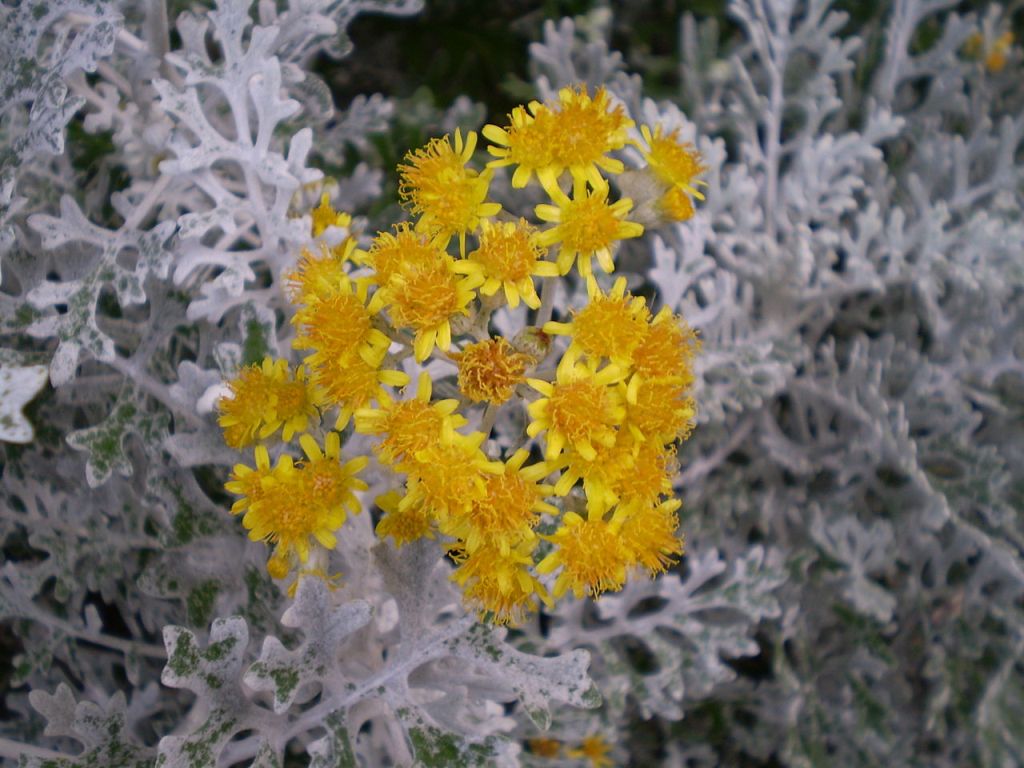
18. J. maritima or Silver Ragwort
A silvery-hairy perennial herb of dry, well-drained soils, widely grown in gardens for bedding and edging and in hanging baskets and window boxes. It frequently escapes into habitats close to human habitations such as walls, pavements, refuse tips, roadside verges and waste ground. It has also been increasingly well-established on cliffs and rough ground near the sea in areas with a mild climate.
As with many other densely tomentose plants, the tomentum, or hair-like pieces on the stems and leaves, is used by some species of bees (e.g. Anthidium anicatum and A. oblongatum in Megachilidae) for nest-building.
Jacobaea maritima is widely used in horticulture for its silvery foliage and is particularly good for pots and in bedding displays. The cultivar ‘Silver Dust’ has gained the Royal Horticultural Society‘s Award of Garden Merit.
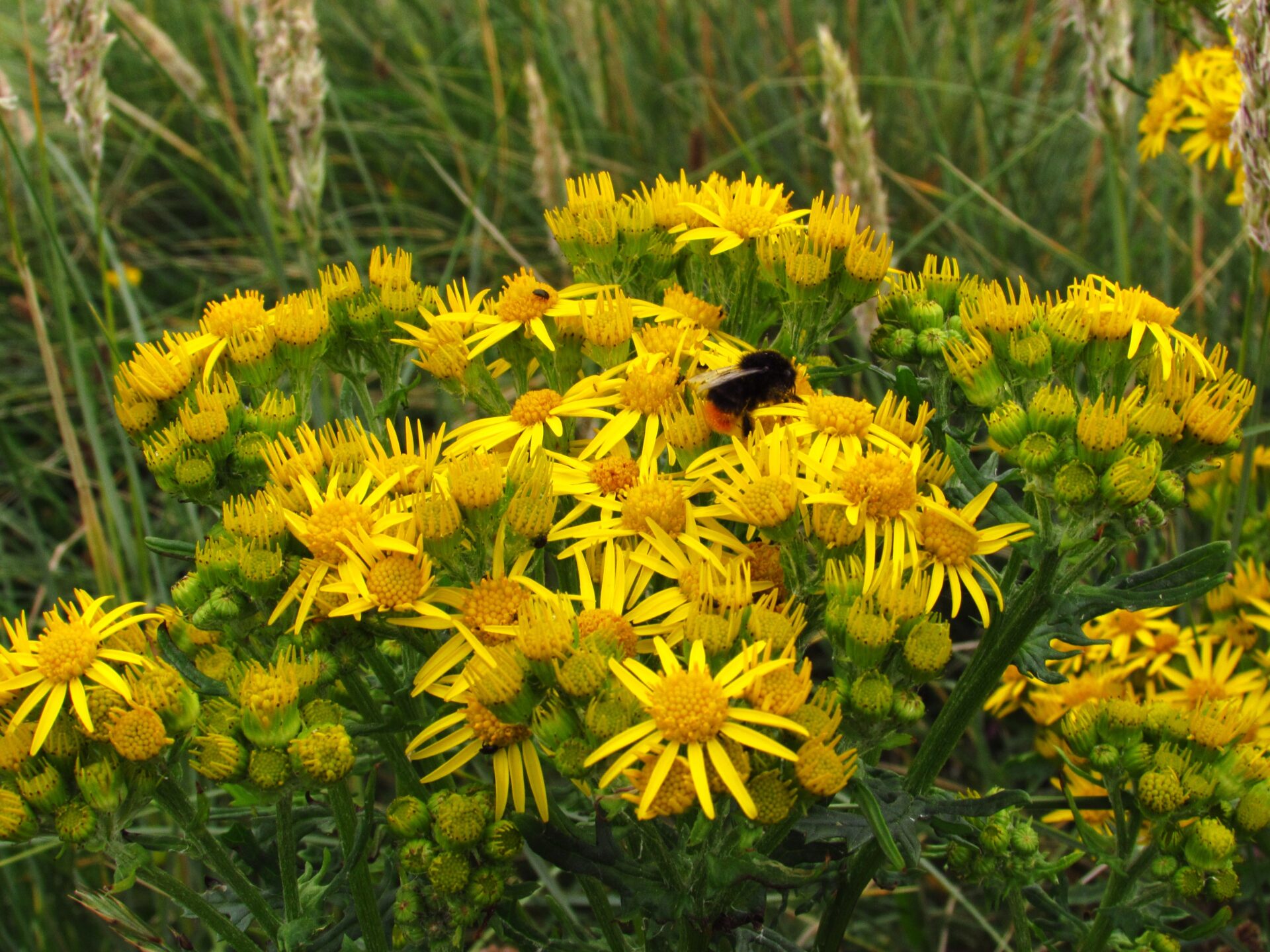
20. J. vulgaris or Common Ragwort
This is by far the most common Ragworts: abtly named Common Ragwort!
A biennial or perennial yellow-flowered herb of grasslands, and especially abundant in neglected, rabbit-infested or overgrazed pastures; it also grows on sand dunes, in scrub, open woods and along woodland rides, waste ground, road verges and waysides, and on rocks, screes and walls.
Ragwort contains pyrrolizidine, toxic to the liver in humans and horses if consumed in quantity, so is specified under the Weeds Act (1959) and Ragwort Control Act (2003). Horses and livestock tend to avoid it whilst grazing, but cannot detect it in contaminated hay.
Negative points about Ragwort:
First of all a bit of negative news from the RHS website about this Common Ragwort before we are going to talk about the beneficial!
All the Ragworts are poisonous weeds of which Jacobaea vulgaris is the most common. It can become a major weed of waste or other uncultivated ground.
The plant is usually a biennial (living only two years and flowering in its second year) but damage to the base of the plant can make the plant behave like a perennial (living indefinitely), as new rosettes are formed.
Ragwort is rarely a problem in gardens but may occur in pony paddocks, railway embankments and areas of unimproved pasture. Cattle and horses are particularly susceptible to poisoning although they don’t tend to eat it in active growth! Cutting, wilting and the treatment with herbicides make ragwort less unpalatable to livestock and poisoning by Ragwort mainly arises from eating contaminated hay.
Common ragwort produces large numbers of seeds which are dispersed by the wind.
Ragwort is covered by the Weeds Act 1959 (which specifies five injurious weeds including common ragwort) and the Ragwort Control Act 2003. For guidance, on good practice and the legal framework for land managers, consult the Code of Practice on How to Prevent the Spread of Ragwort.
Now for the good news!
One man’s invasive vegetation with nothing going for it, is another man’s splash of sunshine that attracts gorgeous insects!
At least 30 insect species (and 14 fungi species) are entirely reliant on Ragwort, of which a third of those are scarce or rare. Ragwort is also an important nectar source for hundreds of species of butterflies, bees, moths, flies and other invertebrates, helping to support populations in the UK countryside.
You can also read about its even medicinal uses in the past on this fabulous website where the author summarises that:
The dead plant, unseen in a bale of hay, is far more harmful than all the living plants seen along roadsides and in fields. So; it is the responsibility of the horse or pony owners to make sure the ragwort is not coming in the hay!
Friends of the Earth came with a really good summing up of why Ragwort is used as one of our black sheep in our countryside with telling us about the 4 common myths around this plant:
Myth 1: Ragwort is a serious risk to horses and cattle
It is mildly poisonous, but the taste of the plant is usually off-putting to livestock. That’s why it’s not unusual to see horses in fields chomping on very short grass but leaving the ragwort – clever things. The danger comes when cut and dried as hay fed to these animals. But bought hay is usually from specific good quality grass and not ‘rubbish’ mixed tough herbs. It is also on the owner to make sure of the quality before he/she feeds it to his/her livestock!
Myth 2: Ragwort is poisonous to humans
Who in their state of minds is going to eat fast quantities of foul testing herbs?
Myth 3: Ragwort must be removed wherever it’s found
When left to its own devices this normal biennial flower dies out after flowering. But has in common with other biennials that if it is not allowed to flower its energy reserves will go into forming a more perennial plant if not removed completely! But the law does not require removal. See more about the laws above.
Myth 4. Pull ragwort out before it goes to seed
As explained earlier this is normally a biennial and will just get encouraged to grow a bigger plant the following year. Yes, the seeds can make new plants in bare soil only; which is not usual in pasture land.
So that was rather a lot on Ragwort alone!
Finishing with pictures by M. Summers of some of the creatures living on this fascinating plant:
